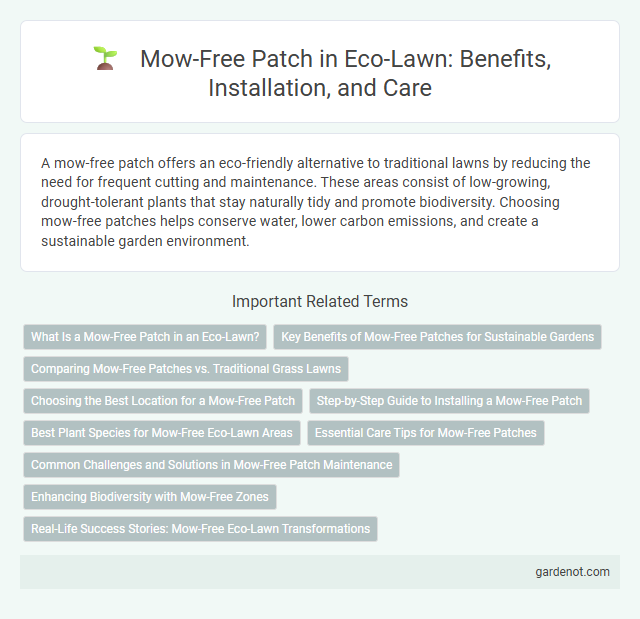A mow-free patch offers an eco-friendly alternative to traditional lawns by reducing the need for frequent cutting and maintenance. These areas consist of low-growing, drought-tolerant plants that stay naturally tidy and promote biodiversity. Choosing mow-free patches helps conserve water, lower carbon emissions, and create a sustainable garden environment.
What Is a Mow-Free Patch in an Eco-Lawn?
A mow-free patch in an eco-lawn consists of low-growing, clover-based ground cover or slow-growing grasses that thrive without regular mowing, reducing maintenance efforts and environmental impact. These patches support biodiversity by providing habitats for pollinators and beneficial insects while conserving water through drought-tolerant plant species. Eco-lawn mow-free areas enhance soil health and minimize carbon emissions associated with lawn care equipment, promoting sustainable landscaping practices.
Key Benefits of Mow-Free Patches for Sustainable Gardens
Mow-free patches significantly reduce maintenance by eliminating the need for regular mowing, conserving time and energy while lowering carbon emissions associated with lawn equipment. These patches enhance biodiversity by providing habitats for pollinators and beneficial insects, contributing to healthier, more sustainable garden ecosystems. Water conservation is improved as mow-free areas often contain drought-resistant plants, reducing irrigation demands and promoting eco-friendly gardening practices.
Comparing Mow-Free Patches vs. Traditional Grass Lawns
Mow-free patches offer a sustainable alternative to traditional grass lawns by significantly reducing water usage and eliminating the need for regular mowing, thus lowering carbon emissions and maintenance costs. Unlike conventional lawns, these patches support biodiversity by providing habitats for pollinators and native plants, enhancing local ecosystems. Their drought-resistant properties and minimal chemical input make mow-free patches an environmentally friendly choice for modern landscaping.
Choosing the Best Location for a Mow-Free Patch
Selecting the ideal location for a mow-free patch involves choosing areas with minimal foot traffic and natural shade to encourage healthy growth of low-maintenance ground covers like clover or native grasses. Soil quality should be assessed to ensure proper drainage and nutrient availability, which supports sustainable plant health without frequent mowing. Positioning the patch near garden beds or along borders enhances aesthetic appeal while reducing overall lawn maintenance efforts.
Step-by-Step Guide to Installing a Mow-Free Patch
To install a mow-free patch, begin by selecting a suitable location with partial to full shade and prepare the soil by removing existing grass and loosening the topsoil. Next, apply a mix of low-maintenance ground covers like clover, creeping thyme, or moss that require minimal mowing and provide durable green coverage. Water the area consistently during establishment, and avoid heavy foot traffic to ensure healthy growth and a sustainable, mow-free lawn alternative.
Best Plant Species for Mow-Free Eco-Lawn Areas
Low-maintenance mow-free eco-lawns thrive with drought-tolerant species like fine fescues (Festuca spp.), creeping thyme (Thymus serpyllum), and clover (Trifolium repens), which require minimal mowing and resist foot traffic. Native grasses such as blue grama (Bouteloua gracilis) and buffalo grass (Bouteloua dactyloides) offer eco-friendly ground cover that conserves water and supports pollinators. Incorporating a mix of these resilient species enhances soil health, reduces lawn maintenance costs, and promotes biodiversity in mow-free lawn areas.
Essential Care Tips for Mow-Free Patches
Mow-free patches thrive with minimal intervention, benefiting from regular watering during dry spells and occasional aeration to promote soil health and root growth. Applying a balanced, slow-release fertilizer in early spring enhances nutrient availability without encouraging excessive top growth that requires mowing. Keeping these areas free from invasive weeds ensures the native or low-growing plants dominate, maintaining the patch's mow-free benefits and ecological value.
Common Challenges and Solutions in Mow-Free Patch Maintenance
Mow-free patches often face challenges such as weed invasion, uneven growth, and soil compaction that hinder their natural appearance and health. Effective solutions include regular selective hand-weeding, using drought-resistant native plant species, and applying organic mulch to retain moisture and improve soil structure. Implementing these strategies promotes sustainable growth while minimizing the need for mowing and chemical interventions.
Enhancing Biodiversity with Mow-Free Zones
Mow-free patches within eco-lawns create essential habitats for pollinators, butterflies, and native insects, significantly boosting local biodiversity. These uncut zones allow wildflowers and native grasses to flourish, promoting a balanced ecosystem and supporting beneficial wildlife. Implementing mow-free areas reduces maintenance efforts while fostering environmental sustainability and resilience in urban and suburban landscapes.
Real-Life Success Stories: Mow-Free Eco-Lawn Transformations
Mow-free eco-lawn transformations have demonstrated remarkable success in reducing maintenance time while promoting biodiversity. Homeowners report vibrant, weed-resistant patches thriving without regular mowing, significantly lowering water usage and carbon emissions. These real-life success stories highlight eco-lawns as sustainable alternatives that combine aesthetic appeal with environmental benefits.
Mow-free patch Infographic

 gardenot.com
gardenot.com